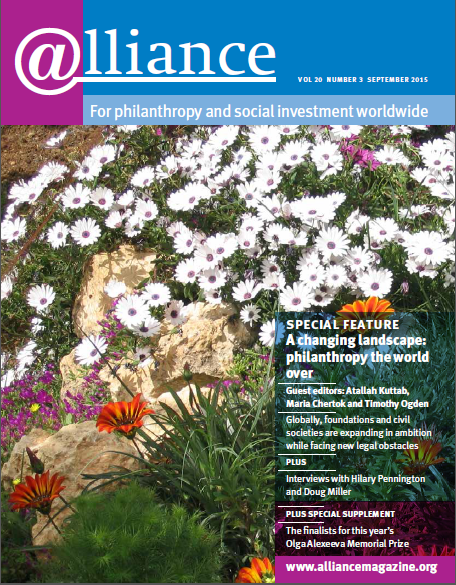Impact investing is creating great excitement in development circles, with breathtaking figures about its potential size and impact bandied about. At the moment, though, its effect is anticipated rather than actual. Will it achieve its potential? How significant will it become in the next ten years? Alliance asked observers in four different regions to speculate.
ASIA
Part of a broader social finance system
Rob John
When America sneezes, Europe catches a cold, it was said of the Great Wall Street Crash. In philanthropy and social investment, too, the US often pioneers, with Europe and Asia some years behind. Impact investing grew from the strong foundations of American philanthropy, but its global expansion is constrained in weaker philanthropy markets. So what role will impact investing play in a region where 1.6 billion people live on less than US$2 day, with growing and complex social and environmental problems?
Wealth creation, intergenerational wealth transfer, a pool of professional talent seeking to volunteer, and the rise of social entrepreneurship will drive the Asian trajectory of impact investing over the next ten years. The development of philanthropy in the culturally and economically diverse countries that comprise Asia will be another key factor.
Although few Asian countries enjoy a satisfactory philanthropy infrastructure or supportive regulatory environment, there is innovation and growing professionalism in the sector.[1] Since 2002, long before the GIIN (Global Impact Investing Network) consortium promoted impact investing globally, Aaviskaar has been investing in Indian social businesses; it now has a track record of successful exits and over $155 million under management. India is fertile ground for impact investing, with an established non-profit sector and a large underserved market for low-cost services. Gray Ghost Ventures estimated that 30 per cent of global impact investing is focused there.
Beyond India many impact investing initiatives are scattered throughout the region. Social Venture Partners Melbourne, a giving circle established in 2013, set aside a loan and equity fund to invest in Australian social enterprises. The Japanese ARUN syndicate invests in Cambodian social businesses. Sow Asia, Transist Impact Labs, and B Current Impact Investment are local impact funds investing in Greater China.
These exemplify the spectrum of experimental impact investing in Asia today. At one end, philanthropists and grantmakers are moving beyond a traditional preference for non-profits towards social enterprises, while at the other end commercial investors are seeking to back businesses with clear social goals. In Asia, as globally, the problem is not lack of funds but the shortage of investment-ready, high-potential social businesses. Intermediaries like Artha Platform (India) and the Impact Investment Exchange Asia (Singapore) are connecting capital to ideas more efficiently. The Non-Profit Incubator in Shanghai or UnLtd Thailand provide seed capital and mentoring to help entrepreneurs in the early stages of building their business model. In India and Pakistan, business angel investors are adapting their commercial approach to help social enterprises become ready for investment by large impact funds.[2]
Impact investing in the US grew by stretching the boundaries of well-established grantmaking over five decades. Asian impact investing will grow effectively in the coming decade if it is part of a broadly developing social finance ecosystem.
Rob John is a visiting fellow at the Asia Centre for Social Entrepreneurship & Philanthropy at NUS Business School, Singapore. Email rob.john@nus.edu.sg
LATIN AMERICA
Financial and social in the same box
Carolina Suarez
In 2010, Latin America set a new record: for the first time, we had more middle-class people than poor. Despite this, the region remains the most unequal in the world. This and quality in education are the most important challenges Latin America faces. Corporations and corporate foundations are leading most of the social interventions: both expect financial returns.
Nowadays in Latin America, particularly in Colombia, Argentina and Brazil, the concept of private social investment (PSI) – understood as the voluntary investment of private resources, used strategically, to achieve measurable and sustainable public results focused on social change – guides the speech of social investors. There is no doubt that those who invest in the accomplishment of social and environmental goals are also seeking returns, not only social but also financial returns.
A recent report notes that ‘they (impact investments) demonstrate that well-managed projects can have significant social impacts while generating financial returns that rival any other class of investment’.[3] Another report, from Bain & Co, remarks that ‘Capital committed by impact investment funds in Latin America increased from USD$160 million in 2008 to roughly US$2 billion by the end of 2013’.[4]
During the next ten years, we will face enormous challenges in the region: first, the decline of international cooperation; second, the growing middle class, which will demand new and better social services. To help address these challenges, governments and policymakers need to design and enforce a legal framework and rules to attract new social investors. Sanchez Zinny highlights that ‘by 2013, 19 per cent of impact investment globally was directed toward firms and organizations in Latin America, despite the fact that only 4 per cent of impact investors globally are physically based in the region.’
Another big challenge is measuring the impact of these investments. There is a need to coordinate the interventions, and to establish adequate metrics to measure the impact.
There is no doubt that impact investing will rule the future of social interventions in the region. Instead of being in different boxes, financial and social concepts will be in the same box. And if we want to see real changes in the world, that’s where they should be.
Carolina Suarez is executive director of AFE (Association of Corporate and Family Foundations) Colombia. Email carolina.suarez@afecolombia.org
FRENCH-SPEAKING AFRICA
Strengthening the SME sector
Firoz Ladak
In recent years, Africa has surfaced on the development map as ‘the new frontier’, with economic expansion over the entire continent forecast at 50 per cent in the next five years. Yet a vast number of Africans continue to live below the poverty line. Poverty, hunger and lack of access to health services and education are huge challenges, while 1 million jobseekers will enter the market every month for the next 15 years. What can impact investing do to meet these challenges?
Until recently, impact investing in Africa has been led primarily by western equity firms that have access to a vast amount of liquidity and are looking for the right investment pipeline in financial services, health, agro-business, energy or even education. Such impact investors are used to practices derived from private equity, including a large ticket size, an ambitious IRR (investment rate of return), management control and an exit strategy. Finding companies that fit such criteria while at the same time answering strict economic, social and governance (ESG) requirements remains challenging. Specialized funds in the field like Leapfrog, Acumen, Abraaj Capital or Root Capital have focused mainly on East or Southern Africa.
SMEs (small to medium-sized enterprises) remain a missing link in the current excitement over impact investing. Most of the small entrepreneurs who represent a huge portion of African economies fail to attract impact investors. On the one hand, the size, risk and financial return of small businesses are below investment grade; on the other, the fact that they generate employment and income does not make them worthy enough in the eyes of social impact ideologists. A reappraisal of definitions and measurement is required.
Another gap is French-speaking Africa, which until recently was not on the radar of private impact investors and continues to depend on aid from donor agencies. The French legacy in countries like Ivory Coast and Senegal means that the state remains the core provider of social good and economic incentive. Yet, as in the rest of Africa, there are outstanding entrepreneurs in Abidjan and Dakar in areas such as IT, health and agro-business. They represent a great opportunity for broadening the scope of impact investing. This is the view taken by Entreprises & Partenaires, a Paris-based investment company led by the former head of the French development agency, which is setting up a $20 million fund of funds across ten West African countries. The intention behind this innovative approach, which rallies a mix of public and private investors, including the Edmond de Rothschild Foundations, is to have closer access to local markets and harness the potential of African SMEs.
Such an ambitious and disruptive initiative demonstrates what impact investing is about: strengthening a flourishing entrepreneurial ecosystem that will lead ultimately to positive and sustainable structural change. And impact investing will in turn benefit from the growth of a sound and vibrant SME sector as long as its outlook remains flexible.
Firoz Ladak is CEO of Edmond de Rothschild Foundations. Email fladak@edrfoundations.org
GERMANY
Securitizing the public good or funding innovation?
Volker Then
The prospects of social impact investing in Germany in the next ten years will depend on three factors: first, will it become more widely known? Second, will there be appropriate business models and maturing market segments to invest in? Third, will more intermediaries emerge to bring together risk profiles and return expectations of investors and investees?
On the first point, the debate on the roles and value of impact investing is widening and is sparking growing interest both from players whom one might expect to get involved, like family offices and foundations, and from a growing number of social enterprises and financial market institutions.
Their interest will turn into realistic growth in the impact investing market if viable investments – our second critical factor – can be found. In a strong welfare state, the capacity of social enterprises to provide these very much depends on aligning the business models with the regulated quasi-markets in which social enterprises are most likely operating. If market failure is not to prevent any development altogether, we need to avoid two things: first, ‘cherry-picking’ – serving customers according to their capacity to pay rather than their social needs; second, using the public budget or social security resources only to provide a profit to private investors – in other words, securitizing the public good. The exception from this rule could be well-justified cases of social innovation which would increase effective social problem-solving.
In strong welfare states like Germany, there is potential for impact investing to complement mainstream social service funding to generate social innovation. In this area, business models may emerge that develop their own niche innovation market and may therefore – at least initially – act independently of state regulation. However, given the hybrid nature of the funding situation and the financial structure of many German social enterprises, it remains to be seen if impact investing can really find a sufficient number of investment opportunities.
Currently the largest market potential seems to be in fields that have emerged from social movements (renewable energy, fair trade, organic food or textile production, ethical banking) and are only partly defined by regulated market conditions. Even in such value-based market niches, the intermediaries to help structure the risk-return profiles of deal candidates and investors are still lacking (there are currently only three).
However, we can see movement. In three years’ time, there should be more intermediaries; in five years we should see an invigorated deal flow; and in ten years impact investing should be established as a promising element of social innovation finance. In the German welfare system and political culture, however, the players will need to be careful not to undermine existing levels of social security.
Volker Then is executive director at the Centre for Social Investment at Heidelberg University. Email volker.then@csi.uni-heidelberg.de
Main image: Low-cost taxis, like this one in El Salvador, generate incomes for owners while providing affordable transportation in low-income communities; impact investors finance similar kinds of businesses.
Footnotes
- ^ See ‘Innovation or imitation: does it matter?’ Alliance, March 2013.
- ^ See ‘Angels, super angels and impact angels’, Alliance, June 2014.
- ^ G S Zinny, Harnessing Social Impact Investing in Latin America www.atlanticcouncil.org/images/publications/Harnessing_Social_Impact.pdf
- ^ A Leme, F Martins and K Hornberger (2014) The state of impact investment in Latin America, Bain & Co website http://tinyurl.com/IILatAm










Comments (0)